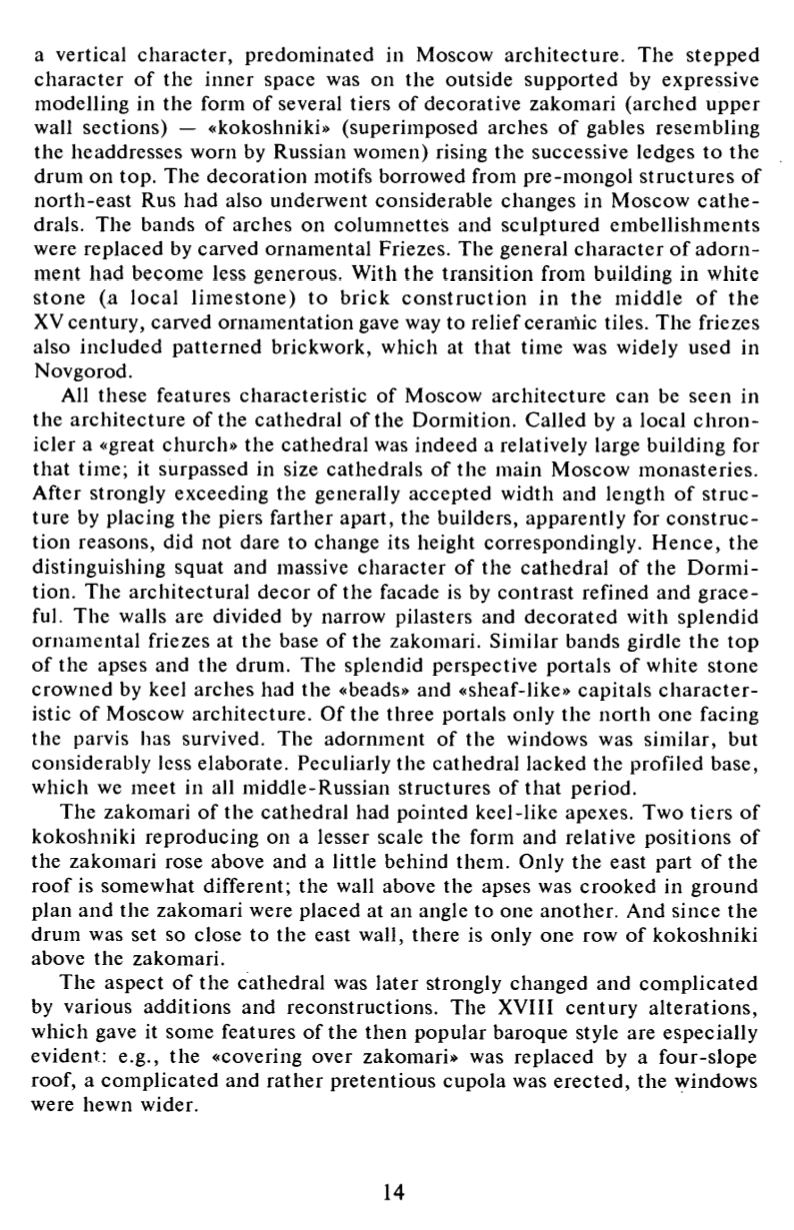

a vertical character, predominated in Moscow architecture. The stepped
cha rac te r o f the inner space was on the outside supported by expressive
modelling in the form of several tiers of decorative zakomari (arched upper
wall sections) — «kokoshniki» (superimposed arches o f gables resembling
the headdresses worn by Russian women) rising the successive ledges to the
drum on top. The decoration motifs borrowed from pre-mongol structures of
north -east Rus had also underwent considerable changes in Moscow c a t h e
drals. The bands of arches on columnettes and sculptured embellishments
were replaced by carved ornamental Friezes. The general cha rac te r o f a do rn
ment had become less generous. With the transition from building in white
s tone (a local lime s tone ) to brick co n s tr u c tio n in th e m idd le o f the
XV century, carved ornamentation gave way to relief ceramic tiles. The friezes
also included patterned brickwork, which at that time was widely used in
Novgorod.
All these features characteristic of Moscow architecture can be seen in
the arch itec tu re of the cathedral o f the Dormition. Called by a local c h r o n
icler a «great church» the cathedral was indeed a relatively large building for
that time; it surpassed in size cathedrals of the main Moscow monasteries.
After strongly exceeding the generally accepted width and length o f s tr u c
ture by placing the piers farther apart, the builders, apparently for con s tru c
tion reasons, did not dare to change its height correspondingly. Hence , the
distinguishing squat and massive character of the cathedral of the Do rm i
tion. The architectural decor of the facade is by contrast refined and g race
ful. The walls are divided by narrow pilasters and decorated with splendid
ornamen tal friezes at the base of the zakomari. Similar bands girdle the top
o f the apses and the drum. The splendid perspective portals o f white stone
crowned by keel arches had the «beads» and «sheaf-like» capitals ch a ra c te r
istic o f Moscow architecture. Of the three portals only the no rth one facing
the parvis has survived. The adornment of the windows was similar, but
considerably less elaborate. Peculiarly the cathedral lacked the profiled base,
which we meet in all middle-Russian structures of that period.
The zakomari o f the cathedral had pointed keel-like apexes. Two tiers of
kokoshniki reproducing
011
a lesser scale the form and relative positions of
the zakomari rose above and a little behind them. Only the east part o f the
roo f is somewhat different; the wall above the apses was crooked in ground
plan and the zakomari were placed at an angle to one another. And since the
drum was set so close to the east wall, there is only one row o f kokoshniki
above the zakomari.
The aspect o f the cathedral was later strongly changed and comp lica ted
by various additions and reconstructions. The XVIII century alterations,
which gave it some features of the then popular baroque style are especially
evident: e.g., the «covering over zakomari» was replaced by a four-slope
roof, a comp licated and rather pretentious cupola was erected, the windows
were hewn wider.
14















